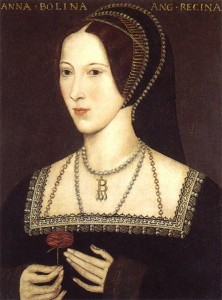 On Saturday 29th April 1536, Queen Anne Boleyn had two separate encounters with two courtiers who would end up being accused of sleeping with her and of plotting the King’s death with her.
On Saturday 29th April 1536, Queen Anne Boleyn had two separate encounters with two courtiers who would end up being accused of sleeping with her and of plotting the King’s death with her.
The first encounter was with Mark Smeaton, a groom of the privy chamber, a court musician and a man who had been “wholly supported and clothed” by the King.1 He was of humble origins and was known as “Mark” at court, rather than Smeaton, showing his lowly status and possibly his youth.
We know about Anne’s encounter with Mark from an account given by Mrs Stonor, one of the ladies chosen to attend Anne Boleyn during her imprisonment in the Tower. The ladies appointed to serve Anne at this time were to report back everything the Queen said or did to Sir William Kingston, Constable of the Tower, who sent daily reports to Thomas Cromwell. According to Mrs Stonor, Anne said of the encounter:
“I never spake with him since, but upon Saturday before May-day [29th April], and then I found him standing in the round window in my chamber of presence; and I asked why he was so sad? And he answered and said it was no matter. And then I said, You may not look to have me speak to you as I should do to a noble man, because ye be an inferior person. No, no, said he, a look sufficeth me; and thus fare you well.”2
As I’ve said in previous articles on this, Anne’s account suggests that Mark had a bit of a crush on her, but that the Queen put him in his place by pointing out his “inferior” status. Mark was arrested the next day and taken to Cromwell’s home for interrogation. There, he confessed to sleeping with the Queen on three separate occasions. He was the only one of the five men tried for treason in May 1536 who pleaded guilty, and he never retracted his confession. When Anne was given an account of his execution, she said “Did he not exonerate me […] before he died, of the public infamy he laid on me? Alas! I fear his soul will suffer for it.”3
Why did Mark Smeaton confess to sleeping with the Queen when the other men all denied it, and the charges against them appear impossible? Well, we just don’t know. According to the Spanish Chronicle, he was tortured, although this is not corroborated by any other contemporary source, and other theories include that he lived in a fantasy world, that he was offered a deal if he confessed (a more merciful death perhaps?), that he was scrupulous (seeing sin when there was none) or perhaps, as John Strype, the 18th century historian, ponders, it was Anne’s reaction to him on 29th April that made him want to “take this opportunity to humble her; and revenge himself”.4 It is impossible to say.
Queen Anne Boleyn’s second encounter was with Sir Henry Norris, Henry VIII’s groom of the stool and close friend. His office made him a powerful man in that he controlled access to the King’s private chambers and he was often approached by petitioners who wanted him to influence the King on their behalf. His son was being educated by the French reformist scholar Nicholas Bourbon in the company of Anne Boleyn’s nephew and ward, Henry Carey. This fact shows that Norris shared the Queen’s reformist sympathies and that he was close to the Queen. He was also courting the Queen’s cousin, Margaret (Madge) Shelton.
On 29th April, it is reported that Anne argued with Norris. Anne had asked him why he was taking so long in marrying her cousin, and when he replied that he “would tarry a time” she rebuked him, saying, “You look for dead men’s shoes, for if aught came to the King but good, you would look to have me”, thus accusing Norris of delaying his marriage to Madge because he fancied her. A horrified Norris replied that “if he [should have any such thought] he would his head were off.”5 It had started off as a game of courtly love, where a knight was meant to woo his queen and be a little in love with her, but ended up with Anne speaking recklessly of the King’s death, something which could be construed as treason. This is why Norris was horrified by her words and also why Anne then ordered him to go to her almoner and swear an oath about her character. I think Anne knew that there was a plot against her and realised that she had just handed her enemy some ammunition. However, it is clear from her words that Anne was reprimanding the courtier for looking to replace the King, not plotting with him to kill the King.
You can find out more about courtly love in the following articles:
- Courtly Love, Flirtation and the Fall of Anne Boleyn: Part 1
- Courtly Love, Flirtation and the Fall of Anne Boleyn: Part 2
Notes and Sources
- Nicholas, Nicholas Harris (1827) The privy purse expenses of King Henry the Eighth, from November 1529, to December 1532: with introductory remarks and illustrative notes, William Pickering, London, Introductory Remarks, XXXI
- Cavendish, George (1825) The Life of Cardinal Wolsey, Volume 2, Samuel Weller Singer, p.37.
- Letters & Papers, Foreign and Domestic, Henry VIII, Volume X, 1036.
- Strype, John (1816) Ecclesiastical Memorials Relating Chiefly to Religion, and the Reformation of It, and the Emergencies of the Church of England, Under King Henry VIII, King Edward VI, and Queen Mary I, Volume I, 436.
- L&P X, 793.